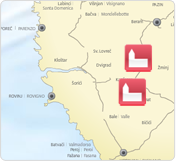
- Gradišće – Koper
- Podpeč – Zanigrad – Hrastovlje
- Slum – Roč – Hum
- Draguć – Paz – Gradinje – Gologorica
- Pićan – Gračišće – Lindar
- Pazin – Beram
- Oprtalj – Čirkoti – Rakotule
- Vižinada – Božje polje – Labinci
- Višnjan – Bačva – Poreč
- Sv. Lovreč – Kloštar
- Šorići – Dvigrad – Kanfanar
- Žminj – Svetvinčenat
- Bale – Batvači – Fažana – Pomer
- Bičići – Barban – Prodol
- Jasenovik – Nova Vas – Vranja
- Plomin – Brseč – Lovran
Žminj – Svetvinčenat
Žminj
St. Anthony
The Austrian conservationist Anton Gnirs bought St. Anthony's Church, which was until then used as a storehouse, from the widow Foška Peteh for a sum of 450 Kronen with the money of the Austrian Archduke and heir presumptive to the throne Franz Ferdinand, and on his behalf. However, even today in land-ownership records Gnirs's name appears as the owner of the building.
The church is built of regular rows and properly dressed stone. On the southern and western walls are preserved Gothic transennae. Stone elements of the window opening on the facade were reconstructed during restoration work around 1964. The church has unique architectural traits and an inscribed apse with a pointed barrel vault, as well as the church nave, articulated by semi-circular niches. The inscription on the facade dating from 1381 bears witness of the names of those who commissioned and built the church. The names Marino, Sladonich and Teodor can be related to the confraternity, most likely bearing the name of the church titular, and depicted on the left wall of the apse. This testifies to the early role of confraternity in commissioning artworks in Istria. On the right wall of the apse are three coats of arms. The left and best preserved one belongs to the Devin family, and the right one is that of the Habsburgs. The scene of the Coronation of the Virgin is depicted in the lunette of the apse. Below it are the frescoes in niches depicting, from left to right: St. Anthony the Abbot, SS. Peter and Paul and another saint with a mitre, pallium and book in his right hand. On the vault of the apse are symbols of the Four Evangelists presented as human figures with heads of their zoomorphic symbols. In the niche of the southern wall is the Adoration of the Magi, and the niches of the northern wall are covered with scenes of the Resurrection and Ascension of Christ. An iconographic curiosity for the macabre theme is the scene of death, i.e. skeleton on the western wall. On the right side of the western wall are fragments of the Lap of Abraham. On the triumphal arch are remains of the Annunciation, whereas on the vault of the nave on each wall two registers with altogether eight scenes, which are unfortunately in a very bad condition. The scene of the Resurrection is discernible. The throne in the scene of the Coronation of the Virgin is surrounded by eight angel musicians playing the psalterium, fiddle, mandore, portative, lute, and tambourine. These are the oldest representations of musical instruments in Istria. The lyrical presentation of angels with elegant gesture of fingers, kneeling with the body in a gently curved position, as well as light, pastel colors of their garments and their subtle cuts suggest the visual language of international Gothic, an expression of refined court etiquette. The complete impression of the painting is defined by the coloring. The dominant color is dark blue, almost black, which is used for the background and the area of velarium. Architectural scenery breaks through this darkness, together with figures in yellow, green and red shades. The scene of the Coronation of the Virgin and the images of saints below it are attributed to the more skilled master, while the less skilled one executed all the other church frescoes. The frescoes have been connected with Venetian artistic tendencies, master who was brought up on the art of Venetian primitives, Pre-Renaissance painters, set by the art of Lorenzo Veneziano, Catarino and Donato. More recent research points to the possible influence of Sienna painting, which over Venice was brought to Istria.
Seite drucken An Freunde senden





















